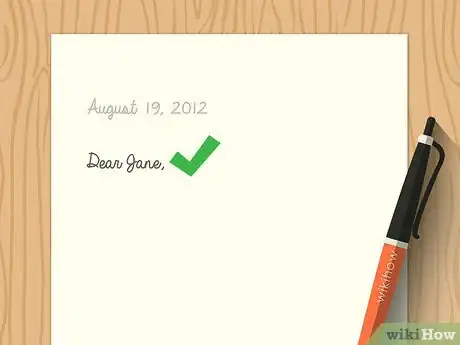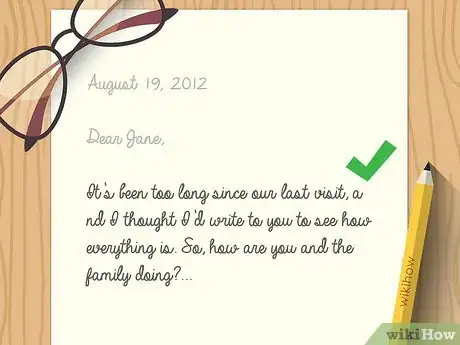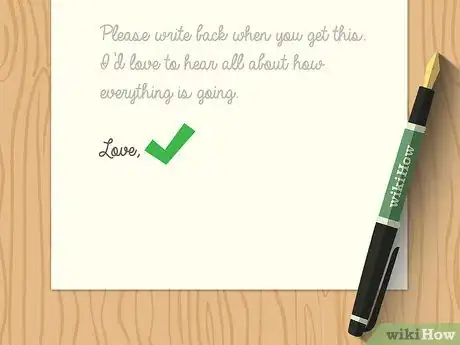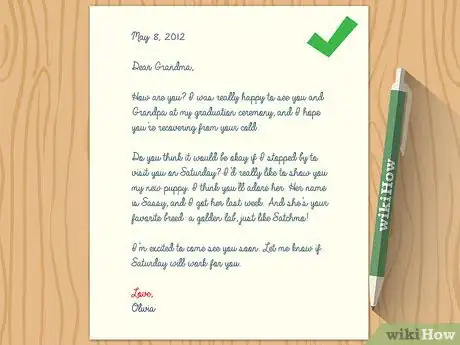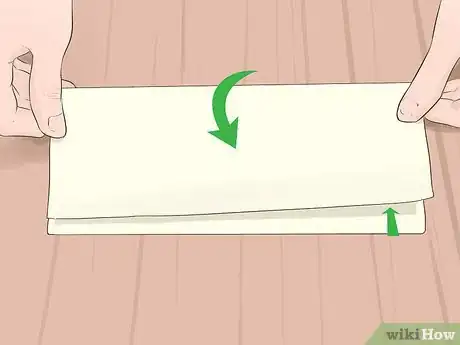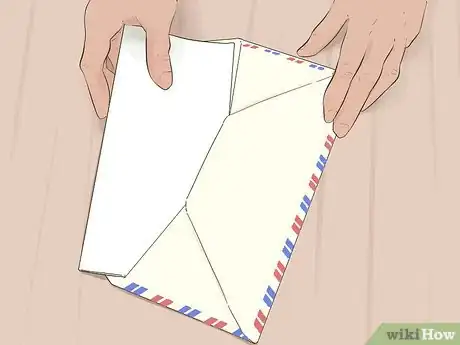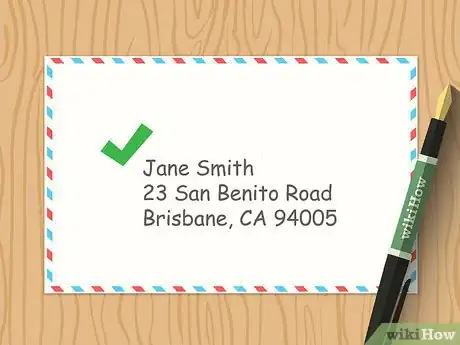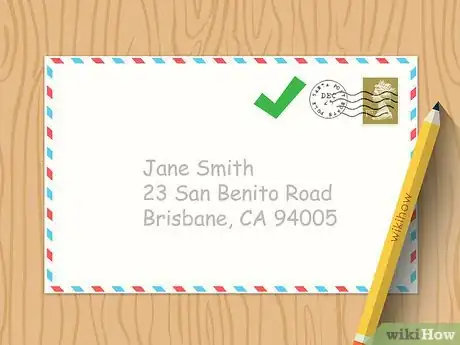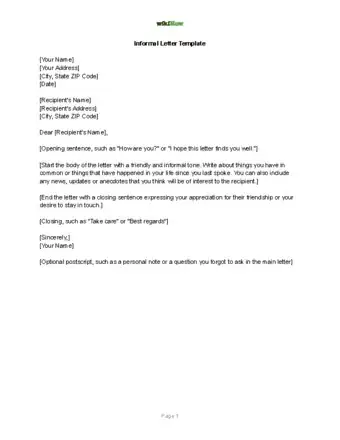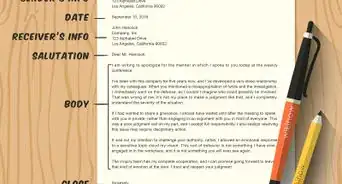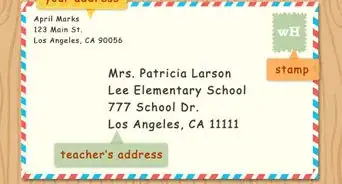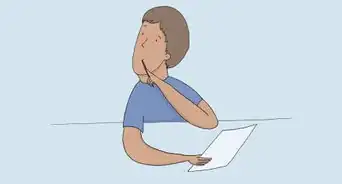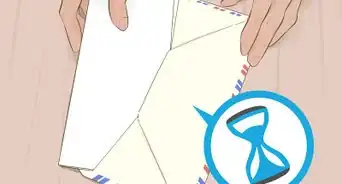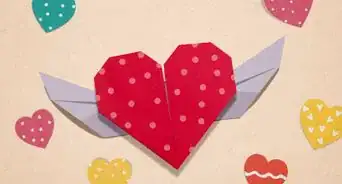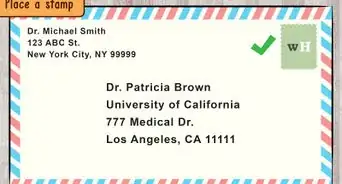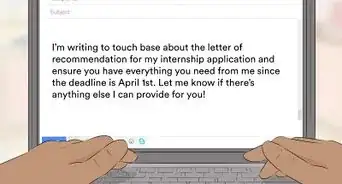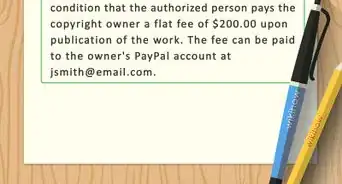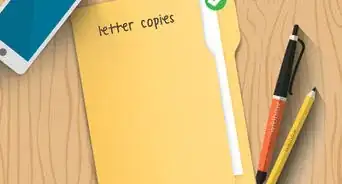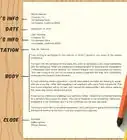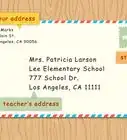This article was co-authored by Tami Claytor. Tami Claytor is an Etiquette Coach, Image Consultant, and the Owner of Always Appropriate Image and Etiquette Consulting in New York, New York. With over 20 years of experience, Tami specializes in teaching etiquette classes to individuals, students, companies, and community organizations. Tami has spent decades studying cultures through her extensive travels across five continents and has created cultural diversity workshops to promote social justice and cross-cultural awareness. She holds a BA in Economics with a concentration in International Relations from Clark University. Tami studied at the Ophelia DeVore School of Charm and the Fashion Institute of Technology, where she earned her Image Consultant Certification.
There are 10 references cited in this article, which can be found at the bottom of the page.
This article has been viewed 124,225 times.
Writing an informal letter is easier than writing a formal one because there are fewer rules to follow. Just address your letter to the person you're writing, fill out the body with what you want to say, then sign your name at the bottom to let your recipient know who it's from. If you want to mail your letter rather than handing it off in person, be sure to put it in an envelope that's been properly addressed and stamped.
Steps
Formatting Your Letter
-
1Note your address and the date (optional). In the upper lefthand corner of a clean sheet of paper or new word processor document, put down your current location in one or two lines. Directly under that, record the day's date, making sure to mention at least the month and year.[1]
- You can either spell out the full date ("Wednesday, February 12th, 2018") or use the abbreviated numeral form ("2/12/18") to keep things simple.
- Including these details is a good way to let your recipient know when and where the letter was written, which can be especially useful if you're in different parts of the world.
-
2Write your recipient's name at the top of the letter. Begin your letter by addressing the person it's intended for by name. Traditionally, the opening address goes in the upper lefthand side of the page, but you can put it anywhere you want as long as you have enough room to include your message beneath it.[2]
- If you want, you can add a salutation before your recipient's name, such as “Dear,” “My darling,” or even just “Hey.”
- If you're composing an open letter and don't know the name of the person who will be reading it, start with a general address like, “To whom it may concern” or “To whoever reads this letter.”[3]
Advertisement -
3Fill out the body of the letter with your message. Use the space underneath your recipient's name to say whatever you want to say. The body of your letter can be as long as you want it to be, so don't feel like you have to keep it within the confines of a single page. Pour your heart out![4]
- Once you run out of room on the first page, start a new one or flip your paper over and continue writing on the back.
- Picking out a lined type of paper, like notebook or journal paper, can help you keep your handwriting neat and organized.
-
4Write a short closing to wrap up the letter. Once you've gotten your message across in the body of your letter, leave a little room (about the space of a single typed line) below your last sentence to include a brief sign-off. Your closing line might say something like, “Sincerely,” “Yours truly,” or “With love.”[5]
- The closing essentially signals to your recipient that they've reached the end of the letter.
- Since you're not sending a formal letter, there's no need to add a closing if you don't want to—you can always just sign off with your name.
Tip: Come up with a closing that reflects your reason for writing. A letter of condolence, for instance, could end with “My deepest sympathies.”[6]
-
5Sign your name at the bottom of the letter. Put your name right under your closing line (if you included one) so that the closing acts as a lead-in for your signature. You can sign your name in cursive or formal script if you like, but it's also okay to simply print or type it instead.[7]
- You might use your full name, first name, or a nickname depending on your level of familiarity with the person you're writing to.
Adding Some Style
-
1Keep your language conversational for a more personable feel. Informal letters are meant to be read in a relaxed, casual way. Feel free to use contractions, hypothetical questions, inside jokes, and other figures of speech. This will help your natural voice come through to your reader.[8]
- If you're not sure what to say, it can be helpful to imagine that you're having a conversation with a friend and simply write the way you would talk.
Tip: You might kick off the body of your letter with something like this: “Hey bestie! Isn't it crazy how time flies? One minute we're chasing boys at summer camp, and the next you're getting married! Being an adult is WEIRD!”
-
2Use colored ink or fonts to liven up your correspondence. Black ink is for newspapers and dull, rigid formal letters. Grab your most vibrant pens or change the default text color in your word processor and put a little personality on the page. Blue, green, red, and other funky shades can all be fun attention grabbers, especially if you're writing to a close friend.[9]
- Mixing up your use of colors is a great way to break up the monotony and emphasize key words or phrases.
- Make sure the color you choose contrasts your letter paper enough to be plainly visible. Otherwise, your message may be hard to read.
-
3Draw in the margins of handwritten letters to lend a little visual flair. Take advantage of the extra space on either side of the page by filling it with doodles, symbols, or quirky notes. Elements like these will allow you to express yourself creatively and give your reader something else to look at.
- You might spice up your description of that time you spotted Bigfoot at the mall by including an artist's rendering of what he looked like.
- Similarly, if you happen to catch a typo while reading back over your letter, you could turn it into a joke by crossing it out and scribbling, “I promise I know how to spell!” next to it.
Mailing Your Letter
-
1Fold your letter twice vertically so it will fit in an envelope. Take the bottom two corners of your letter paper and fold them about ⅓ of the way up the sheet. Then, fold the doubled section over one more time to create a neat that will fold in any business envelope.[10]
- This method works best with standard 8.5 inches (22 cm) x 11 inches (28 cm) printer paper, but it can be used to fold papers of other sizes, too.
-
2Place your letter in an envelope and seal it up. Slip your letter into the envelope widthwise to make sure it will fit. To seal the envelope, lick the glue strip lining the inner edge of the flap to moisten it. Then, lower the flap and apply gentle pressure for a few seconds until the adhesive sticks.
- Keep in mind that envelopes come in various shapes and sizes. If you're having trouble cramming your letter into a standard business envelope, try shopping around for one that's a better fit.
Tip: If you don't like the idea of licking your envelope, you can also use a damp sponge, cotton swab, or glue stick to make sure it stays closed.
-
3Print your recipient's mailing information on the face of the envelope. Somewhere near the center of the envelope, write the person's first and last name, their full address, and the city, state or province, and postal code where they live.
- Don't forget to specify an apartment number after the street address if your recipient doesn't live in a house.
- If you want the person to know who the letter is from before they open it, scribble your own address in the upper lefthand corner of the envelope.[11]
-
4Stick a stamp in the upper righthand corner of the envelope. Position your stamp directly across from the return address, where it can easily be seen by your mail handler. Once you've applied the proper postage to your letter, you'll be ready to drop it in the mailbox and send it off to your recipient![12]
- Know How Many Stamps to UseMost letters up to 1 oz require one stamp, unless they are an odd shape or not uniform in thickness.
- Affixing your postage somewhere other than the upper righthand corner of the envelope could confuse the sorting machine at the post office. In some cases, your letter may even be sent back to you.
Informal Letter Template
Community Q&A
-
QuestionHow do I write a letter as a parent informing my son's teachers that he has a heart disease?
 Tom De BackerTop AnswererIf you can, give them this information in a personal conversation. It's much quicker and much more informal than any letter, and you can easily answer their questions right away. Otherwise, write a letter simply stating the facts, and suggest to talk about this the next time you meet if they have questions.
Tom De BackerTop AnswererIf you can, give them this information in a personal conversation. It's much quicker and much more informal than any letter, and you can easily answer their questions right away. Otherwise, write a letter simply stating the facts, and suggest to talk about this the next time you meet if they have questions. -
QuestionHow do I write a letter to a cousin I met once about 50 years ago? I want information about my family so I can pass down to my children and grandchildren.
 Kim GTop AnswererYou can start by introducing yourself, explaining how you are related to them, and how met. Possibly mention a few other relatives they may know to help break the ice. Then you can explain your reason for writing to them, giving them some examples of what you want to know and why. Always be polite, and respect their wishes. If they don't want to communicate with you, don't take it personally, but it is possible you may be able to reconnect with a family member.
Kim GTop AnswererYou can start by introducing yourself, explaining how you are related to them, and how met. Possibly mention a few other relatives they may know to help break the ice. Then you can explain your reason for writing to them, giving them some examples of what you want to know and why. Always be polite, and respect their wishes. If they don't want to communicate with you, don't take it personally, but it is possible you may be able to reconnect with a family member. -
QuestionHow can I write a letter to my friend telling about my new school, such as student population, payment of school fees, displine, student/teacher activities, school bus, sport activities, laboratories, libraries?
 Kim GTop AnswererYou can start by saying what you enjoy about the school. What activities have you joined, what the classes are like, what types of sports teams they have, what the students are like. Then you can contrast this by writing about some things you miss about your old school, and ask your friend about how they are doing at school. You don't have to include all the information in one single letter, in fact it would be a good way to keep in touch with your friend.
Kim GTop AnswererYou can start by saying what you enjoy about the school. What activities have you joined, what the classes are like, what types of sports teams they have, what the students are like. Then you can contrast this by writing about some things you miss about your old school, and ask your friend about how they are doing at school. You don't have to include all the information in one single letter, in fact it would be a good way to keep in touch with your friend.
Things You'll Need
- Letter paper
- Ink pen or pencil
- Multicolored writing utensils (optional)
- Envelope (optional)
- Postage stamp (optional)
References
- ↑ https://www.toppr.com/guides/english/writing/informal-letters/
- ↑ https://www.readingrockets.org/article/introduction-letter-writing#act4
- ↑ https://www.skillsyouneed.com/write/letter-writing.html
- ↑ https://www.toppr.com/guides/english/writing/informal-letters/
- ↑ https://www.letters.org/letter-closings.html
- ↑ https://en.oxforddictionaries.com/writing-help/choose-the-right-greeting-and-sign-off
- ↑ https://www.readingrockets.org/article/introduction-letter-writing#act4
- ↑ https://www.skillsyouneed.com/write/formal-or-informal.html
- ↑ https://www.familyeducation.com/life/writing-letters/writing-letters-letter-format
About This Article
To write an informal letter, start by writing your recipient’s name at the top of the letter with an appropriate salutation, like “Dear,” “My darling,” or “Hi.” Once you greet your recipient, fill out the body of the letter with your message, which can be as long or as short as needed. When you’re done writing your message, write a short closing to wrap up the letter, like “Sincerely,” “Yours truly,” or “With love.” After this closing, sign your first name, full name, or nickname, depending on your level of familiarity with the person you’re writing to. If you want to add a personal touch to your letter, use fun colored ink or draw pictures in the margins. To learn how to send your informal letter, keep reading!

